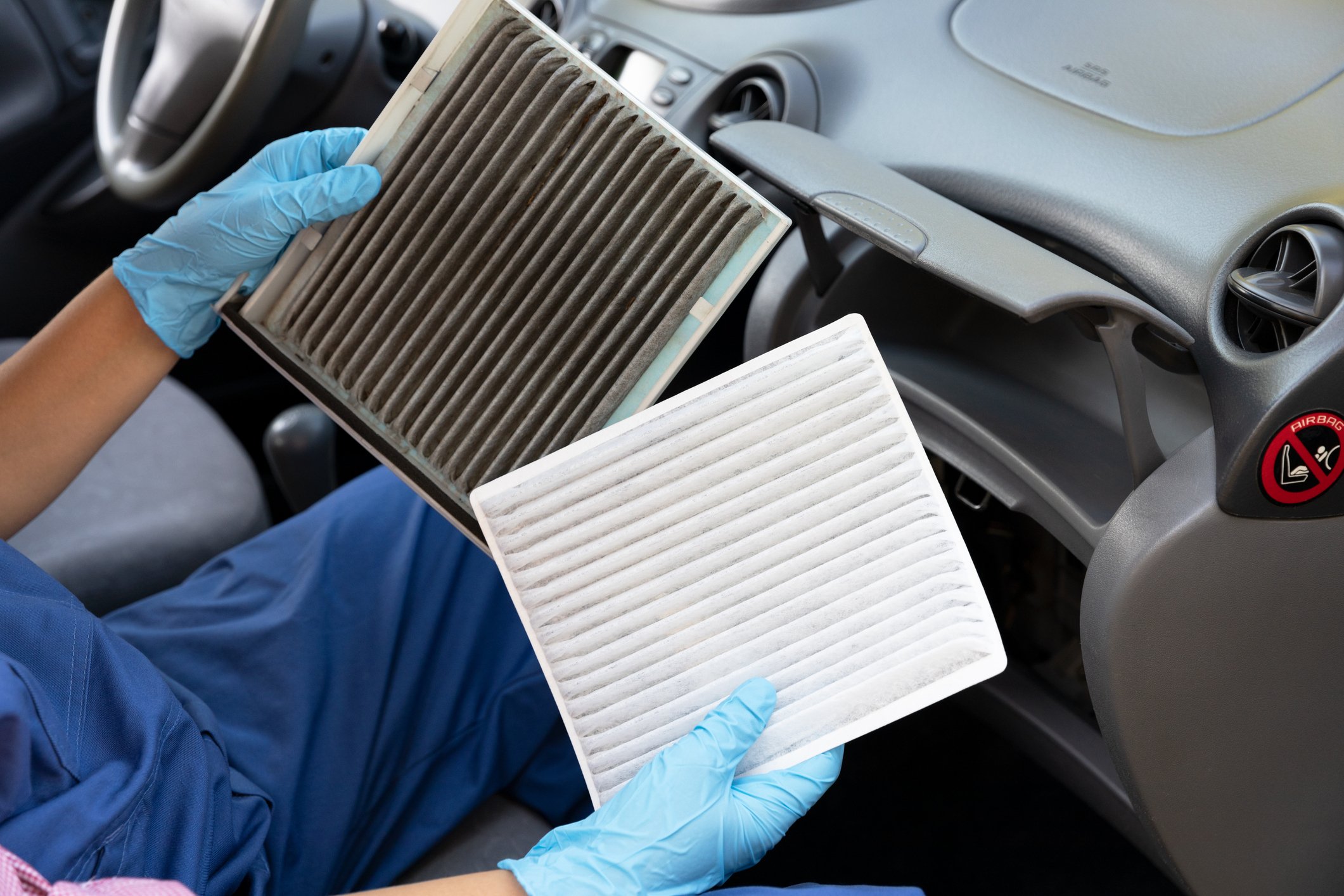How to Fix AC Blowing Hot Air: Tips & Tricks for Professionals
Learn tips from our experts at Tinker DIY on how to fix your car's AC when it only blows hot air.
Table of Contents
There’s nothing worse than turning on your car’s AC on a hot day only to feel warm air blowing from the vent. A car’s AC system can stop working for several reasons, from low refrigerant levels to a faulty condenser or electrical issue. This guide will walk you through the common problems, preventative maintenance, and step-by-step DIY fixes to help you get your air conditioner blowing cold air again.

Common Reasons Your Car’s AC Blows Hot Air
When your car’s AC starts blowing hot air instead of cold air, it’s usually a sign of an issue within the AC system. From low refrigerant levels to electrical problems, several common issues can prevent your air conditioner from keeping you cool. Here’s what might be causing the problem.
Low Refrigerant Levels
Refrigerant is the lifeblood of your car’s AC system, allowing it to produce cool air. If there’s a refrigerant leak, the AC system won’t have enough refrigerant to function properly, leading to warm air blowing from the vent instead of cold air.
Causes of Low Refrigerant Levels:
- Road debris damaged the condenser, leading to a refrigerant leak.
- A worn-out orifice tube failing to regulate refrigerant flow.
- Leaks in the expansion valve, AC hoses, or other components.
Signs of Low Refrigerant:
- Hissing sounds when the AC is running.
- Warm air coming from the passenger side or driver side vents.
- Visible fluid leaks near the AC components.
Faulty AC Compressor
The AC compressor is a vital component that pressurizes and circulates the refrigerant throughout the car's AC system. If the compressor isn’t functioning properly, the system won’t generate cold air.
Signs of a Broken Compressor:
- Unusual grinding or squealing noises.
- The AC system fails to engage.
- The car AC blows hot air instead of cooling.
Common Issues:
- A seized compressor clutch prevents the compressor from turning.
- An electrical issue or faulty wiring disrupts power to the compressor.
Clogged or Broken Condenser
The condenser plays a crucial role in cooling the refrigerant after it absorbs heat from the cabin. If it becomes blocked or damaged, the AC will struggle to function efficiently.
Signs of a Faulty Condenser:
- The car's AC system has trouble maintaining a steady temperature or airflow.
- Unusual rattling, humming or buzzing noises
Causes of Condenser Issues:
- Road debris blocking airflow to the condenser fan.
- A refrigerant leak due to cracks or punctures in the condenser.
Blown Fuse or Electrical Issues
A blown fuse in the fuse box or a problem in the electrical system can stop the AC system from working entirely.
Symptoms of Electrical Issues:
- The air conditioner doesn’t turn on.
- The AC cycles hot air and cold air intermittently.
Quick Fix:
- Check the fuse box under the hood or near the glove box and replace any blown fuse.
- Inspect for faulty wiring or an electrical problem in the system.
Blocked Cabin Air Filter or Blend Door Malfunction
The cabin air filter ensures clean air flows through the AC system. When it’s clogged, it can restrict airflow and cause the system to underperform. Additionally, a blend door malfunction can prevent the correct mix of hot and cold air.
Signs of a Blocked Filter or Blend Door Issue:
- Weak airflow from the upper vent or rear vent.
- Musty or other unpleasant odors
- Excessive condensation and water buildup in car or vents
- Inconsistent temperature settings between the passenger side and driver side.
Solutions:
- Replace the cabin air filter if airflow is weak.
- Check for a stuck blend door that could be preventing cool air from reaching all vents.

Step-by-Step DIY Fixes for a Car’s AC Blowing Hot Air
If your car’s AC system is blowing hot air instead of cool air, there are several DIY steps you can take to troubleshoot and fix the problem before heading to a repair shop.
Step 1: Check the Temperature Setting & Vent Controls
- Ensure the temperature setting isn’t accidentally set to warm air.
- Verify that the upper vent and rear vent are open and directing airflow properly.
- Check for a blend door malfunction, which could be preventing cold air from reaching the driver side or passenger side.
Step 2: Inspect the Refrigerant Levels
- Use a pressure gauge to determine if refrigerant levels are low.
- If needed, use a DIY refrigerant recharge kit to bring levels back to the proper refrigerant level.
- If the AC still isn’t working, a refrigerant leak from the expansion valve, orifice tube, or faulty condenser may be the issue.
Step 3: Examine the AC Compressor & Condenser Fan
- Listen for a clicking sound when turning on the AC system—no sound may indicate a broken compressor.
- Check for road debris blocking the condenser fan, which could prevent the system from cooling properly.
- Inspect the AC compressor and hoses for signs of wear or leaks.
Step 4: Inspect the Electrical System & Blown Fuses
- Locate the fuse box under the hood or near the glove box and check for a blown fuse.
- If the AC system isn’t turning on, inspect for faulty wiring or an electrical problem affecting power to the blower motor or compressor.
- Test the cooling fan to ensure it’s running when the AC is on.
Step 5: Clean or Replace the Cabin Air Filter
- A clogged cabin air filter restricts airflow, making it harder for the air conditioner to push out cool air.
- Check behind the glove box for the cabin air filter and replace it if it’s dirty.
- Weak airflow from the vent may also indicate a problem with the blend door.
By following these DIY steps, you can fix many common AC issues and get your car AC blowing cold air again without an expensive trip to a professional mechanic.

Preventative Maintenance to Keep Your Car’s AC Running Cold
Keeping up with regular maintenance can help prevent your car’s AC system from blowing hot air when you need it most. By following these simple steps, you can keep your air conditioner in peak condition and avoid costly repairs.
Run Your AC Regularly
Even in colder months, turn on your air conditioner for a few minutes each week to keep the AC compressor lubricated and prevent dry seals. This helps ensure the system is ready to deliver cool air when summer arrives.
Keep the Condenser and Cooling Fan Clean
Dirt, leaves, and road debris can block the condenser fan, preventing the system from cooling the refrigerant properly.
- Use compressed air or a gentle wash to remove buildup from the condenser.
- Check the cooling fan for obstructions that could restrict airflow.
Replace the Cabin Air Filter Regularly
A clogged cabin air filter can restrict airflow, making it harder for the AC system to push out cold air effectively.
- Weak airflow from the upper vent or rear vent may be a sign of a dirty filter.
- Check your owner’s manual for the recommended replacement schedule.
Check and Maintain Proper Refrigerant Levels
Low refrigerant levels can strain the AC system, leading to warm air blowing from the vent instead of cool air.
- If the AC starts blowing warm air, check the proper refrigerant level and top it off if needed.
- Frequent refills may indicate a refrigerant leak, which should be inspected.
Inspect Belts and Hoses for Wear
The car’s AC system relies on belts and hoses to circulate refrigerant and power components like the AC compressor.
- Cracked or worn-out hoses can lead to a refrigerant leak.
- A loose belt may prevent the AC compressor from engaging properly.
By following these preventative maintenance tips, you can help extend the life of your car AC and keep it running efficiently year-round.

Learn How to Repair Your Car with Tinker DIY
Fixing your car’s AC system yourself can save you hundreds of dollars in labor costs while helping you build confidence in handling common car problems. Instead of rushing to a repair shop for every AC issue, you can take control of the diagnostics and repairs with the right guidance.
At Tinker DIY, we provide step-by-step guides and expert advice to help you troubleshoot and fix issues like a faulty condenser, blown fuse, or refrigerant leak. Whether it’s learning to replace a cabin air filter, inspect an AC compressor, or check refrigerant levels, we make the process simple and accessible.
Join the Tinker DIY community to get real-time help from experts, exclusive repair tips, and troubleshooting support, so you can keep your car’s AC system running cold without the hefty repair bill. Download and try Tinker DIY today!
Resources:
https://technician.academy/what-does-an-orifice-tube-do-in-an-ac-system/


